- Home
- Feature Articles
- El 'Héroe' cumple 225 años
'The Hero' reaches 225 years
Friday, July 20, 2018
Number: 66
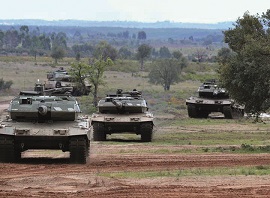
The nickname "The Hero" was given to the 16th Armoured Regiment "Castilla" for the bravery which its members showed in the Second Siege in Zaragoza during the War of Independance. Its heirs are aware of the past and the present of the Unit which they serve. With this certainty they face the "responsability to continue to fight daily to make sure that the Regiment ‘Castilla’ is effective and resolute as Spain requires" in the words of its chief, Colonel Garcia del Castillo.
In recent times, this daily fight has been concentrated in transforming the regiment successfully through the latest adaptations. This has meant that they have gone from having an Armoured Battalion and another Mechanized Batallion to an Armoured Battalion and a new Cavalry group, the "Calatrava". The creation of the Armoured Cavalry Group "Calatrava", in October 2015 meant the return of the Cavalry to Badajoz, after half a century of being absent and therefore a big challenge. To start a new unit and integrate it into such an old regiment was not a simple task, but its members have made it possible.
The "Calatrava" was constituted on the basis of a segregated squad from the 12th Cavalry Regiment "Farnesio". One of the members of this squad was the soldier De La Fuente who decided to pack his suitcase and accompany 20 of his comrades who opted to transfer from Valladolid to Badajoz to participate in the creation of a new Group.
De La Fuente spent 6 years in a Cavalry Exploration Vehicle, always in the "Farnesio". This experience as well those of the rest of the veterans was a fundamental contribution in the starting of the "Calatrava". "Many of the sergeants were newly incorporated and had to do a corresponding course of the armoured/ mechanized units therefore the oldest were involved in the training of the new soldiers, many recently arrived from the training center", he remembers.
Precisely, a high percentage of the personnel arrived to the group as their first post and this caracteristised and defined it in its first moments. The support from the 'Merida' Battallion of this Regiment has been and continues to be fundamental, which has given "Castilla" a virtuous balance between veterans and younger people.
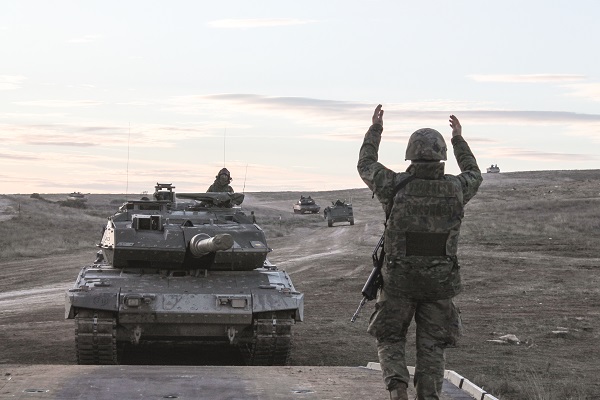
The current chief of the Battalion Merida" II/16, Lieutenant Colonel Garcia Martin didn´t live the first moments as he took command just last year but he has been a witness and provided a continued good relationship that exists between the two units. "It´s like when you are the older brother and you have a younger brother who you look after" he explains. When the members from "Calatrava" arrived , they two units needed to share the space, the command building was divided into two wings, and the depots was also divided. The Maintenance Unit of the tanks of the Batallion started to support the Group, the battalion even contributed some of their tanks to the "Calatrava", as did other units. One knows that sharing even between "brothers" can be difficult sometimes,however, this wasn´t the case according to these militaries.
The lieutenant Nunez of the 2nd Squad was another of those who has worked to "build a routine and turn the wheel" of the Group. The "Calatrava" was his first destination after leaving the General Academy and it has been "exhilarating" for him being able to leave his mark there. "Not everyone can do it, and even less so in their first job" he explains. The biggest disadvantage from his point of view has been the lack of experience of the personnel which between 80-85% of the team didn´t have. With a lot of effort and "dedicating many hours" this circumstance has been improving.
This platoon was that which made up from the root of the 2nd Squad of the Group which in the first months only had the 1st of this Group and the Staff "My platoon is the one which migrated from one sqaud to another because it was the one with the most experience", he emphasises.
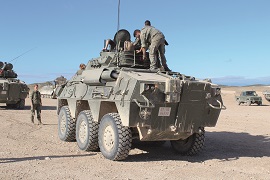
Since then, the Group has continued to grow and now has two Light Armoured Twin Squads, each one has three platoons and a troop of mortars and another one of staff. The Calvary Exploration Vehicles and the "Leopardo" tanks also arrived little by little from the different units of the Army and the current situation makes the lieutenant Nunez dream to go on an international mission with the Squad, a dream which his comrades from "Merida" have been able to fulfill. This Battalion was the one in charge of bringing the platoon of tanks to the Tactical Group which the 6th "Extremadura" Brigade deployed in Latvia in the first Spanish rotation which Spain gave to the NATO mission "Enhanced Forward Presence" in 2017. For the Battalion, the mission meant a huge honour and an opportunity to put in practice during an international mission, the instruction and training which is carried out day to day by the unit.
However, this also implies a big effort to ensure that the materials were deployed in their best condition. In this way, they understood what it should be like given that they knew that they would not return to Spain with them but that they would stay there to replace them.
This fact has meant a temporary reduction in the provision of Leopards in national territory which has been resolved little by little by the sending of tanks to Badajoz from other units. This capacity to overcome and adapt to the changes in order to survive is the the trademark which began 225 years ago and if someone asks its motive the answer is in the hymn: ‘Castilla’ always was like that.
- Exhibitions of historical and patrimonial collections in the old ‘Capitania’ of Badajoz. A total of 4 rooms each one dedicated to a different thematic collection, in order to go into depth of the history of 'Castilla'.
- A series of conferences History of 'Castille' with talks about its role in the War in Cuba , in the War in Morroco and the War of Succession.
- Race of cohesion of the whole regiment in the operation area in the "General Menacho" base.
- Static exhibiton in the Patio de Armas of the Unit.
- Military Parade which included the renewing of the flag of the unit. The Marquise of Cea, heir to the House of Infantado and therefore to the founder of the regiment, the Duke of the Infantado was the godmother.
- Military and Popular Music Concert in the ‘Lopez de Ayala’ Theatre of Badajoz, led by the Orchestra of the Land Force Headquarters. Zarzuela, popular themes and well-known military melodies.
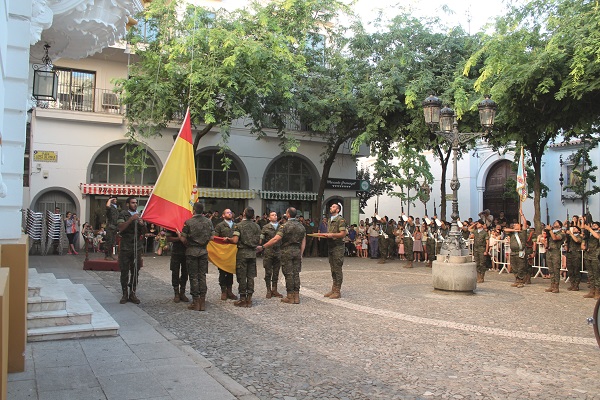
The military parade on 19th May was the act which concluded the 225th anniversay
- Creation: 1st June 1793, at the expense of the 13th Duke of Infantado, given the name "Regiment of Volunteers of Castille". Its creation was to increase the troops destined for the the war against the French Republic.
- First actions of war: in the Roussillon Campaign (1794-1795) against France, where they were congratulated for their bravery.
- War of Independance (1808-1814): They stood out in their defence of the citys of Valencia and Zaragoza, especially in the Second Site of Zaragoza where they were given the nickname "The Hero".
- War in America (1815-1821): They fought against the insurgent forces in Mexico winning in the Terpeaca action in 1821, the right to carry in left sleeve a shield with the slogan "For the Integrity for nations of Spain".
- First Carlist War (1833-1841): They carried important actions in order to win, in the occupation and later defence of the "Canteras de Utrillas" (Soria). For these actions, el Regimet was given two rewards of the ‘Real y Militar Orden de San Fernando’ for each one of their Batallions.
- Decade 1840-1850: Fights in different occasions with Carlist troops in Catalunia.
- War in Africa (1859-1860): Diverse fights, actions and battles in which it was victorious. In 1860 in the Was-Ras battle, in which they waded in Guad-el Jelu river, attacking the enemy which forced him to flee.
- In 1833, after having occupied various garrisons in national territory, it was destined for the plaza de Badajoz.
- War in Cuba (1868-1989) they participate in many actions in which they show great courage.
- Civil War (1936-1939) awarded with the Collective Military Medal. In this time, the regiment has 17 battalions.
- Ifni Campaign (1957-1958) it takes part in operations to maintain of the national sovereignty in the Western Sahara.
- Changes to its name : in 1960 they take the name of 16th Independant Infantry Group "Castilla", in 1963 the name changes to 16th Independant Infantry Regiment "Castilla". In 2015, it changes to 16th Armoured Regiment "Castilla".
- Creation of the Armoured Cavalry Group "Calatrava" which was integrated into ‘Castilla’ in October 2015.
- Missions: Bosnia -Herzegovina, Iraq,Kosovo, Lebanon and Latvia in the operation which has meant the debut of the tanks in an abroad operation.
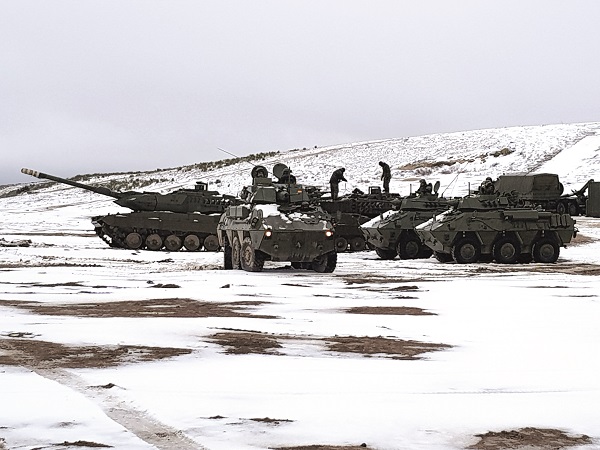
ARMY UNITS
- Araba Álava |
- Albacete |
- Alicante |
- Almería |
- Asturias |
- Ávila |
- Badajoz |
- Barcelona |
- Burgos |
- Cáceres |
- Cádiz |
- Cantabria |
- Castellón |
- Ceuta |
- Ciudad Real |
- Córdoba |
- A Coruña |
- Cuenca |
- Girona |
- Granada |
- Guadalajara |
- Gipuzkoa |
- Huelva |
- Huesca |
- Islas Baleares |
- Jaén |
- León |
- Lleida |
- Lugo |
- Madrid |
- Málaga |
- Melilla |
- Murcia |
- Navarra |
- Ourense |
- Palencia |
- Las Palmas |
- Pontevedra |
- La Rioja |
- Salamanca |
- Segovia |
- Sevilla |
- Soria |
- Tarragona |
- Santa Cruz de Tenerife |
- Teruel |
- Toledo |
- Valencia |
- Valladolid |
- Bizkaia |
- Zamora |
- Zaragoza



